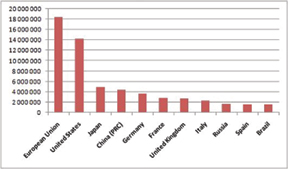As we discussed in Part 1 of this series, wading through the mystique surrounding the popular focus of the year 2012 is actually a study in cycle theory. Without regard for the Mayan Long calendar, scholars and analysts, extrapolating from the cycles of human history, have reasoned that the coming years will be extraordinary.
Long ago, someone else was searching for meaning in an otherwise troubled world—his name was Solomon.
As Solomon explains, there is a time to every purpose under heaven. We are the generation that will witness a radical global shift of “purpose” that will strain the capabilities of individuals, businesses, support organizations, and government administrations.
The Foundation for the Study of Cycles
Richard Mogey, Director of Research for the Foundation for the Study of Cycles, has worked with leading academicians and scientists from Harvard, Yale, Princeton, Oxford, Temple University, Western Reserve as well as other global institutions to build archives of cyclical data spanning 5,000 years. According to Mr. Mogey:
I’ve dedicated my entire adult life to studying the natural cycles that govern the universe and all of human existence —including the cyclical ebb and flow of stocks, currencies and commodities. I’m proud to occupy the position at the Foundation for the Study of Cycles that was created by President Herbert Hoover’s chief economist, Edward R. Dewey, nearly 80 years ago.
It is of interest that this Foundation was put in place to study historical cycles and determine if the factors that brought about the Great Depression could have been foreknown and likewise changed. The results of years of studies provided the “revelation that economies, investment markets and individual investment vehicles move in regular, rhythmic, predictable cycles—one of the greatest breakthroughs in financial history.”
Considering the current condition of economic collapse around the world, and the U.S. in particular, one might wonder if the knowledge of cycles is all that helpful. However, experts had been warning for years that a domino-like collapse was inevitable.
2012 Economic Cycles
The convergence of economic and geopolitical cycles for the United States in 2012 paints a picture worthy of note: one that may or may not come as a surprise to anyone watching current events.
Beginning in 2010 and converging to an all-time low in 2012 are the valuations of the 20- and 60-year cycles of the U.S. GDP (Gross Domestic Product).
According to the International Monetary Fund figures for 2008, the U.S. is currently behind the European Union, but staying well ahead of Japan and China (see chart, below).
In the light of other cycle predictions, the tide could change rather rapidly. The valuation of the dollar against gold is also expected to reach a low peak during this period. While some would speculate that this turn would be only temporary as it has been in the past, another convergence may adversely impact the recovery time of these economic cycles.

According to the Foundation, every 500 years, there is a geopolitical power shift moving east to west or west to east. Converging with these economic low cycles in 2012 is the anticipated geopolitical shift of power from the West (U.S.) to the East (Asia).
The debate between the financial analysts (wealth is moving to Asia) and the geopolitical analysts (the U.S. will remain a dominant world power) will be interesting to watch. Depending upon the outcome of these cycles, the U.S. may very well feel as if an apocalypse has occurred.
The U.S. Past, Present, Future
William Strauss and Neil Howe are researchers and observers of American and human history. Their writings, including the 1994 Generations: The History of America’s Future, 1584 to 2069, depicts the cyclical themes in social psychology within America since the time of the Pilgrims.
Observations through the looking glass of cycles have caused Strauss, Howe, and other institutional analysts to suggest that the period between 2005 and 2015 will see a merging of “economic, social, cultural, ecological, technological, geopolitical, and military distress and disruption of unprecedented magnitude.”
Unfortunately, Strauss and Howe lead a myriad of voices characterizing this as a time of “unique opportunity”—a chance, if not an obligation, to craft a new civic order.
Is This the “Change” We’ve Been Hearing About?
These are not the cosmic catastrophes predicted in ancient cultures or popularized in modern entertainment; these are the predictions of analysts who have studied the cycles of human existence. To a serious student of Biblical eschatology, the results are striking.
John L. Peterson, founder of the Arlington Institute, a non-profit future-oriented think tank, presented his thoughts regarding preparation for the coming storm of 2012 [emphasis mine]:
To ultimately become part of a global effort, there are four general functions that must become an integral part of any organization, business, or government (whether local or national).
Anticipation
• We must learn how to anticipate what is coming our way before it shows up, otherwise every big event is a surprise.
• Anticipatory roles and capabilities must be encouraged throughout the social system—government, business, schools, homes and families.
• A communications and response capability will have to be implemented to quickly and effectively communicate early warning signals to all levels of society.
Innovation
• The rapid development of new theories of adaptation and resilience must be encouraged to determine how organizations, governments, and families can organize and prepare themselves for external shocks.
• Considerable incentives should be established to encourage practical new ideas about living well using less energy and other resources.
Adaptation
• A priority must be established to make all levels of society more resilient and adaptive to change.
• A major initiative must be put in place to familiarize the general populace with the potential implications of big changes and convince them of the importance of getting ready for the times ahead.
• Decentralization must become a national value.
• Breakdown scenarios must be studied so everyone can become familiar with failure possibilities.
Education
• Incentives should be put in place to encourage a search for historical models of how societies adapted (or not) to big change.
Continuing with Peterson’s analysis [emphasis mine]:
Implementing this level of institutional change is very hard and, for governments, unprecedented. A strong leader must have clear mental pictures of both the implications of staying the course and the necessity for change coupled with a pointed sense of urgency for his actions.
Are these the foundations for the “Change You Can Believe In” slogans that permeated the 2008 U.S. Presidential election? Keep in mind that 2012 is also the next election for that post.
Moving Forward
Rahm Emanuel (White House Chief of Staff) has declared, “Rule 1: Never allow a crisis to go to waste, they are opportunities to do big things.” According to the current U.S. administration, all aspects of life are now in “crisis mode.” The speed with which “change” is being achieved is startling.
The advocates of the 2012 “Age of Aquarius” collapse of the old world system and rebirth of a new, enlightened world system would have us believe that our position in the solar system and the position of the stars in a pagan zodiac will dictate the future of mankind. In truth, there is a carefully planned agenda. Visionary and 1969 “Humanist of the Year,” R. Buckminster Fuller once said, “You never change things by fighting the existing reality. To change something, build a new model that makes the existing model obsolete.” The launching of this “new model” between 2010 and 2012 is the most worrisome of 2012 chaos theories.
Solomon explains in Ecclesiastes 2:13-14, “Then I saw that wisdom excelleth folly, as far as light excelleth darkness. The wise man’s eyes are in his head; but the fool walketh in darkness: and I myself perceived also that one event happenth to them all.”
This is a time to ensure your walk is in the light with eyes wide open to the events surrounding you.
By 2012 this new world, born out of the creative minds and compassionate hearts of self-empowered visionaries everywhere, will be even more visible and influential, affecting every aspect of life.
—John L.Peterson A Vision for 2012: Planning for Extraordinary Change
Next month in Part 3 we will conclude this series with an analysis of the road being paved to usher in 2012 and the agenda that is hiding behind the cloak of the 2012 phenomenon.
Notes:
Sources:
- Braden, Gregg. Fractal Time: The Secret of 2012 and the New World Age. United States: Hay House, 2009.
- Compilation of Essays. The Mystery of 2012: Predictions, Prophecies & Possibilities. Boulder, CO: Sounds True, Inc. 2007, 2009.
- Melchizedek, Drunvalo. Serpent of Light: Beyond 2012. San Francisco, CA: Red Wheel/Weiser, 2007.
- Peterson, John L. A Vision for 2012: Planning for Extraordinary Change. Golden, CO: Fulcrum Publishing, 2008.





